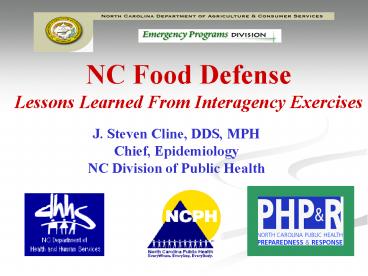Food Defense-NC Lessons Learned - PowerPoint PPT Presentation
1 / 28
Title:
Food Defense-NC Lessons Learned
Description:
Provide oversight to NC Food Defense Project. Co-Chaired by Public Health & Ag ... Industry & Government Training. Conduct Exercises. NC Food Defense Exercises ... – PowerPoint PPT presentation
Number of Views:44
Avg rating:3.0/5.0
Title: Food Defense-NC Lessons Learned
1
NC Food Defense Lessons Learned From Interagency
Exercises
J. Steven Cline, DDS, MPH Chief, Epidemiology NC
Division of Public Health
2
- FOOD DEFENSE
- United States and North Carolina have an
agricultural economic base - Food and agriculture are critical infrastructures
- Threats exist that could cause tremendous toll in
human animal suffering/death, as well as
economically cripple the state and the nation - National priority to harden our food chain
3
Agriculture in North Carolina
- 2nd in Turkey production
- 2nd in Swine production
- 3rd in Poultry production
- 18 of the workforce
- Large variety of crops (not just tobacco)
- Agribusiness 62 Billion Annually
4
Swine
Goats
North Carolina Live Animal Shipments
Sheep and Lambs
Live animals are shipped to a total of 27 states,
Puerto Rico, Mexico, Canada and South
America! The accidental introduction of a disease
such FMD would have a devastating national impact!
Poultry
Beef Cattle
Dairy Cattle
5
NORTH CAROLINA FOOD SECURITY PROJECT
Protecting North Carolinas food supply and our
economy!
6
NC Food Safety and Security Task Force
- Public-private partnership
- Increased collaboration and communication
- Began November 2001
- Formalized by Executive Order 52 signed Sept 2003
- Provide oversight to NC Food Defense Project
- Co-Chaired by Public Health Ag
7
Interagency Project Team Composition NCDACS NC
Public Health NC SBI NC DOJ NCCCPS Other NC
Agencies NC Insurance Commission Industry
Organizations Federal Agencies Other States
8
Project Components
- Seamless approach to surveillance/signal
detection - Threat Assessment
- Vulnerability Assessment Process
- GIS Database
- Integrated Threat Reduction Plan to Mitigate,
Respond Recover - Industry Government Training
- Conduct Exercises
9
NC Food Defense Exercises
- Silent Prairie - June 2003
- Top Off 2 - May 2003 (Remote Monitoring)
- Dark Pantry - June 2003
- Crimson Sky, Crimson Winter, Crimson Guard -
Sept. 2003-February 2004 - Silent Farmland - Aug. and Oct. 2003
- Triple Play - Oct.-Dec. 2003
10
Dark Pantry A North Carolina Food Security
Exercise
11
Dark Pantry
Exercise Objectives
To exercise NC capabilities to prevent, detect,
respond to, and recover from an attack on the
states food supply. To determine support
requirements and assistance necessary from state
and federal agencies To identify shortcomings
and inefficiencies in capabilities To assess
communication and coordination between Public
Health, Ag, emergency response organizations, and
law enforcement with industry stakeholders
12
Dark Pantry
Exercise Outcomes
- Identify and Examine Key Policy issues for an
effective, interagency response to a
bio-terrorism event in NC - Examine current response, containment and
recovery plans for dealing with a bio-terrorism
event in NC - Examine inter-agency coordination, resource, and
force multiplication capabilities required for
such an event - Examine the public-private cooperation,
coordination and resource requirements for such
an event.
13
Dark Pantry
DEC 0
1
2
3
4
5
6
8
10
16
18
30
7
9
Botulinum
Anthrax
2384 268
Sick
0 0
0 50
1072 178
1545 200
599 103
ICU
0 0
0 17
391 66
502 88
Dead
0 0
0 8
209 28
497 36
1012 45
14
Multi Hazard Threat Database
- Password Protected
- Secure Socket Layer Connection
15
16
(No Transcript)
17
(No Transcript)
18
Lessons LearnedFood Defense Perspectives
- Communications
- Partnerships
- Planning
- Assessment
- Mitigation
- Resources
- Training
- Legal
19
Communications
- Single most important element of success
- Emergency vs. Non-Emergency
- Communications systems
- Maintain Contact Lists
- ICS key
- Situational vs. Intelligence Sharing
- Example ISAAC
20
Partnerships
- Redefine working together
- Respect Industrys position
- You cant do it all and you cant do anything by
yourself - Trust
- Example SART - CARTs
21
Assessment
- Sector Specific
- Assess Threats and Vulnerabilities
- Involve Law Enforcement
- Example Exotic Newcastle Disease
22
Planning
- Written Interagency Protocols
- Must be Sector Specific
- Dont be surprised
- Recovery is the key
- Example White Powder Protocol
23
Mitigation
- Bring prevention thinking to the table
- Things Industry may not think of or has not had
to deal with (e.g. mob control, rationing food,
media/risk communication) - Example Infectious Disease Mitigation Plan
24
Resources
- Lab capacity
- Workforce Development
- Listen to Industry needs
- Mechanism for securing funds during an emergency
- Ongoing funding/sustainability
- Example Ag labs back-up to LRN
25
Training
- Keep it simple
- Think modular
- Act small but think big
- Practice-Practice-Practice
- Example UNC Learning Management System
- One Medicine Conferences
26
Legal
- Law Enforcement involvement
- Security Clearances
- Liability red herring
- Example Forensic Epidemiology
27
Parting Shots
- Should preparedness funding account for
agriculture risk? - Shouldnt we have a national Consumer Complaint
System? - Why arent we adding state agriculture labs to
the LRN? - How do we harden the US Postal Service?
28
NC Food Defense Lessons Learned From Interagency
Exercises
Thank You J. Steven Cline, DDS, MPH
steve.cline_at_ncmail.net































